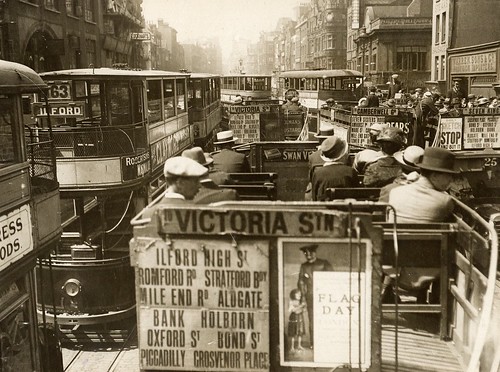Source link : https://londonnews24.com/2025/01/16/gallery/aldgate-terminus-london-c1920/

I’m sure this photo originates from somewhere in London Transport-land, when I worked there. However, it is an image that has fascinated me since I first saw it as it is so atmospheric and there’s so much to see in it. The photographer has captured not just five trams and four buses but a lost streetscape and Londoners going about their daily business – for work or pleasure, we don’t know.
The two buses, on the 25 heading west to Victoria Station, should in theory have been 3 minutes apart but traffic congestion isn’t new in London! they’re waiting for the trams, three lined up to the left, to reverse as the two ahead are doing, at the stub tram terminus outside Aldgate East tube station that you can just see on the right with the vertical “UndergrounD sign. This tram terminus had been determined by the fact that at this spot lay the boundary between the Metropolitan Borough of Stepney that allowed the London County Council to install and operate tramways and the City of London that did not. It was to bedevil the tram, and in time trolleybus, operations here until the end of electric street traction here in 1961. Here terminated and reversed trams on services 53, 61, 63, 67 and 71 – routes that ran out through the densely populated East End and on into metropolitan Essex. Severla of these routes, such as the 63, were jointly operated with other municipal operators such as West Ham Corporation and Ilford Corporation Tramways and I think car 2 may be an Ilford car? There is of course no overhead for the trams as at this point they are are all on the conduit system with the power rails set beneath street level with the trolley poles all fixed down. They will come into use at the changeover pits near Mile End station and elsewhere east.
Heading east in this scene can be seen a bus, a B-type I think, on route 25 heading out through Ilford to Seven Kings and the modern 25 does something similar. Behind can be seen a bus going to Wanstead and that is likely to be on the long established 10 that ran up from Elephant & Castle with many journeys extended to Woodford Bridge and eventually beyond. The 10 and its replacements lasted a long time, partially dying I recall with the Victoria line opening in 1968, subsequent N E London route changes and later withdrawals. In the midst is a southbound 42 off to Camberwell Green having set off from Finsbury Park.
The buildings have all mostly long gone. Aldgate East station was famously relocated, platforms and entrances both, further east in 1938 as part of a scheme to ease congestion on the District, Circle & Metropolitan lines around this area and redevelopment has seen almost two subsequent generations of structures around here.
Then there are the bus conductors and passengers. I can’t see a bare head and it is a fine day! Worth remembering that although the trams have now all been adapted to carry top deck covers bus passengers and crews had effectively a decade to wait before such luxury was accorded them. From the various adverts carried by the trams and buses we can buy matches, whisky and marmalade to name a few! Otherwise this is the heart of the old East End – Whitechapel and the Commercial Road – one of the busiest places on earth at the time and just a couple of years afyer the end of the war to end all wars. I suspect nearly everyone in this image would have been scarred in some way by that.
Posted by mikeyashworth on 2020-04-14 18:45:09
Tagged: , London , London transport , Aldgate , City of London , Stepney , Whitechapel High Street , tram , tram terminus , London County Council Tramways , London tram , London bus , London General Omnibus Companu , LGOC , AEC , B-type , open top bus , double deck tram , Aldgate East station , architecture , streetscape , urban landscape , East London , Mike Ashworth Collection
The post Aldgate terminus, London, c1920 first appeared on London.
—-
Author : london
Publish date : 2025-01-16 21:41:02
Copyright for syndicated content belongs to the linked Source.